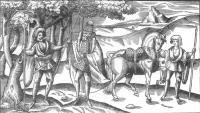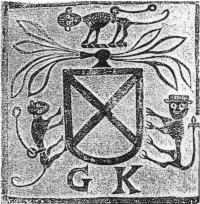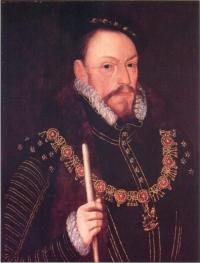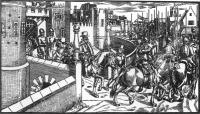Collaborator and Survivor? Gerald the eleventh Earl of Kildare and Tudor Rule in Ireland
Published in
Early Modern History (1500–1700),
Features,
Gaelic Ireland,
Issue 2 (Summer 1994),
Volume 2

An Irish lord, his attendant and his kern from
John Derricke, The Image of Irelande (1581).
Collaboration usually implies betrayal, or deviation from some sanctified cause. Viewed from the opposite perspective, it is an ingenious, even admirable recipe for survival. This article considers the role of one magnate in Irish colonial society in the sixteenth century. It suggests a set of options in the face of the process of conquest and colonisation which characterised the Irish early modern period, especially the option of resistance or participation. An established model is invoked, that of the native in opposition to the newcomer. The survivor, the collaborator, co-operates with the newcomer in the subjection of the native. What could be simpler, what could be more obvious? But is this an accurate interpretation of the situation in Ireland in the sixteenth century? In particular, is this an appropriate model by which to approach the role of the ‘native’ elite in the Tudor conquest of Ireland? Certainly the older, usually nationalist, interpretation, and some recent studies in the field of ‘colonial’ history, adopt such a rudimentary model. These two schemes rarely consider the role of the native nobility in any comprehensive or analytical fashion. The older interpretation, in particular, examined the actions of individual magnates, and either approved of their contribution to the story of native resistance or condemned individual nobles because of their collaboration with the forces of Tudor government and Protestant England.

A stone rubbing of a 1578 version of the
Fitzgerald arms.
Cultural brokers
Recent work on colonisation in the Atlantic world has shown the process of conquest and colonisation to be far more complicated and ambiguous. Research on the process of identity formation and ideological conflict has highlighted the problem of dual identity and the existence of middle groups who had a prolonged and pivotal importance as cultural brokers in the early colonial situation. These middle or survival groups, victims and participants in the colonial process, defy easy labelling and force us to re-examine the issue of collabaration and survival. In the context of the sixteenth-century conquest of Ireland, the magnate descendants of the twelfth-century Anglo-Norman colonists constituted one such survival group. These Old English lords, who had simultaneously resisted and assimilated aspects of Gaelic society, found themselves pushed from the other side as Tudor policy in Ireland created a new aggressive English colonial elite. Lacking a comprehensive modern study of the older colonial elite, this study of Gerald Fitzgerald eleventh Earl of Kildare has the limited goal of examining the problems of interpretation which are specific to this subject, by focusing on the crucial period 1550 to 1572. Kildare’s importance as an Old English lord on the border of the predominantly English Pale and his kinship and patronage connections with the Gaelic Irish clans make him an appropriate focus for study. Marriage links within his own extended dynasty, the ‘Geraldines’, and similar ties with most of the major Gaelic chieftains gave him an extensive network of Irish obligation and influence. In stark contrast, family connections in England, contacts at court, an alliance with the ascendant Leicester faction, and his importance for the security of the borders of the Pale, point to him as a pivotal ‘English’ figure whose activities spanned both sides of the Irish sea.
An Irish ‘politique’
Here was an Irish ‘politi que’ in an officially Protestant state, married to a committed Catholic and English noblewoman, Mabel Browne. While his position dictated that he enforce the reformation, she sheltered Jesuits and encouraged Catholic subversives. And despite his friendship with the Earl of .Leicester, the most sophisticated of English courtiers, Kildare also fostered his children with local Gaelic families. How do we make sense of these multiple identities, and how can they help us understand his motivations and actions in this period? One way is to re-examine the nature of the changing relationship between the crown and its Irish subjects in the sixteenth century. Prior to this period, the Old English lords, as the representatives of English law and government in the midst of Gaelic ‘barbarity’, had benefited from royal neglect to the extent that they controlled their territories almost in the manner of independent fiefdoms. The chief beneficiary of this delegation of royal responsibility had been the Geraldines, and, in particular, their Leinster branch, the Earls of Kildare.
Kildare Ascendancy
After 1470 this dynasty achieved almost complete control over the apparatus of effective royal government in Ireland. In particular their near monopolisation of the post of the Irish lord deputyship gave them control over the English Pale, and an influence throughout the island. Their earldom formed a buffer zone between the Pale, the most effective area of English settlement, and the neighbouring and hostile Gaelic lordships. In effect, the crown had ‘privatised’ its government in Ireland. In return the earls of Kildare kept the peace and secured the borders through a combination of military might, the ‘assimilation’ of Gaelic custom, and an extensive range of marriage alliances with their Gaelic neighbours. This period of English governmental neglect came to an end in 1534 when Henry VIII was forced to intervene directly in Irish affairs in order to crush the revolt of his most prominent Irish servitor, Garret Og Fitzgerald, eleventh Earl of Kildare. On crushing the Kildare revolt, the various Tudor governments thereafter found themselves increasingly committed to the maintenance of an English-appointed and born lord deputy, to a royal garrison, and to direct involvement with the Gaelic lordships on the borders. From the 1550s onward this contact became increasingly embittered as the Gaelic lords resisted the various colonisation schemes with which the crown tried to secure the ever-expanding borders of the Pale.
Elizabethan conquest
Across the rest of the country, crown policy was characterised by an increased militarisation and a more aggressive attitude towards the social reformation of the Gaelic Irish. One impact of these measures was the creation of a new class of English soldiers, settlers and administrators who had a vested interest in replacing the older colonial elite as the representatives of English SOCiety in Ireland. Nicholas Canny’s Elizabethan Conquest of Ireland has concluded that these combined efforts represented the establishment of a pattern, which by the end of the century would result in the final conquest and colonisation of the entire island. But how should we view the role of the Old English elite in this process? This depends in large measure on how one interprets both the intention of Tudor policy, and the Old English reaction to it. If we interpret Tudor policy as directly aiming at their emasculation, then those who cooperated in the process were collaborating in the ruination of their fellow countrymen. From this perspective, Tudor government policy in Ireland aimed at undermining the power of the local Old English nobles by extending English law and government to their lordships and by ensuring the abolition of their private armies. Canny interprets the crown’s efforts in the 1560s and 1570s in this light. He specifically credits the government of Sir Henry Sidney (1565-71, 1575-8) with a major assault on the Irish lordships. He argues that the government’s interest in colonisation and its dogged commitment to a programme of undermining Old English regional power increasingly alienated the ‘older’ English elite while giving sustenance to the growing New English group. Sir Henry Sidney’s scheme to establish provincial presidencies in Connacht and -Munster is seen by Canny as an attempt to defeat the native Old English and Gaelic lords by extending English law and government to their lordships and by ensuring the abolition of their private armies. According to this approach aggressive lord deputies, accelerating New English colonisation schemes, and a developing internal and international religious tension, all fundamentally affected the native magnates’ pOSition within the Irish and English polities. The end result of the efforts of these programmatic governors, and of Sir Henry Sidney in particular, was noble alienation and rebellion.

Portrait of Thomas Radcliffe, third Earl of Sussex by unknown artist. (COURTESY OF THE NATIONAL PORTRAIT GALLERY, LONDON)
Return of the earl
A focus on the career of Gerald Fitzgerald eleventh Earl of Kildare as a test case, however, seriously challenges aspects of this interpretation and forces a re-examination of concepts of resistance and collaboration. Kildare, whose title and lands were partially restored by the crown after his exile on the continent, returned to Ireland in October 1555. The Geraldine earl strove to recreate the factional networks with the Gaelic Irish that were formed under his predecessors, to restore Kildare control on the borders, and to recover the office of the chief governorship for his house. In order to achieve these goals, Kildare needed to reactivate his family’s traditional alliances. Shane O’Neill, Donough O’Connor and the Kavanaghs, all leading Gaelic regional lords and opponents of the government, came to his castle at Rathangan in 1555 and in an entertainment which lasted over a month re-asserted traditional local and national GaelicGeraldine alliances. Kildare also moved in this period to reconstruct the various semi-feudal duties and Gaelic military measures which had been abolished by the government after his family’s rebellion. In particular the much resented series of Ga~lic military impositions known as ‘coign and livery’ (the forced billeting of armed retainers on the local population) were almost immediately revived. Traditionally this mechanism maintained the earl’s private army. These measures suggest that Kildare intended to operate in the same semifeudal, semi-Gaelic manner as his predecessors.
They were sufficient to precipitate a conflict with the new government and political forces which had established themselves in Dublin. The English-born governors and their retinues, the New English captains and soldiers, and the new colonies of English settlers in the midlands, all represented forces hostile to the rebirth of an ‘over-mighty’ Earl of Kildare. In a major policy change, starting with the Earl of Sussex in the 1550s, the crown had essentially farmed out its government in Ireland to a new style of governor. With a clear programme, a set timetable, and an agreed royal subvention, Sussex promised to rid the crown of its endemic Irish problem. The English courtier’s analysis of the problem suggested the necessity of the following steps: increased colonisation; an assault on the Gaelic lordships on the borders; the overthrow of Shane O’Neill, the leading Gaelic rebel; and a disarming of the Old English nobles in order to put a stop to their violent feuding.
Sussex’s government subverted
Sussex’s radical programme ran counter to Kildare’s interest at every turn. Each of its major components represented serious challenges to his newly restored lordship. Colonisation in the midlands threatened a traditional Kildare zone of control. Shane O’Neill was Kildare’s leading Gaelic ally. And finally the abolition of coign and livery threatened the chief source of his local muscle. In response the earl used every means available, short of outright rebellion, to obstruct the lord deputy’s proposals. Using all his traditional factional connections, Kildare successfully subverted Sussex’s government. As the leading military official on the Pale borders, he had the job of hunting down the midlands’ O’Mores and O’Connors who were fighting to protect their lands from English settlement. Using the wild terrain as an excuse, Kildare half-heartedly pursued these traditional dynastic allies. Harnessing resentment in the English Pale against increased taxation to pay for the lord deputy’s campaign, Kildare, as its premier noble, supported a general ‘tax’ strike. In an effort to encourage resistance, the Geraldine engaged in regular progresses, meetings with Gaelic chieftains, and had ‘masses’ said pUblicly. In an act of open defiance, Kildare fostered his children with Gaelic families. At the same time, the earl used his court connections to mount a sustained campaign to discredit the Earl of Sussex. Partly because of Kildare’s covert assistance and intelligence, the governor’s costly and repeated campaigns failed to hunt down the formidable Gaelic rebel Shane O’Neill.
O’Neill’s submission
His programme in tatters, and his status compromised by the alternative authority of Kildare, Sussex left Ireland a failure. Not before the Earl of Kildare, however, had peacefully led his Gaelic ally Shane O’Neill in submission before Elizabeth and her startled court in January 1561. In a publicity coup of enormous symbolic importance, the Old English Earl of Kildare led an abject and ‘howling’ Shane O’Neill before the queen and her courtiers. The exoticness of this ‘staged’ performance impressed those present but it should not blind us to the essential message behind Kildare’s spectacle. It was the native aristocracy, and Kildare in particular and not ‘upstart’ English aristocrats who knew how to control the borders and tame the ‘wild Irish’. Kildare had not openly resisted crown policy during the Sussex administration, nor had he clearly collaborated with it. In effect he walked a fine line between the two. This subversive success prompted Sussex’s remaining allies in the administration to suggest that Kildare’s followers, both Gaelic and Old English, aimed at a restoration of ‘native’ control and an extermination of the New English. For these officials at least, Xildare’s use of coign and livery, his nurturing of Gaelic warlords, and his subversion seemed to fit the more modern idea of anti-English resistance.
Appointment of Sidney
If this is how Kildare responded to the initial efforts of interventionist English government, what then could we expect when Sussex’s successor, Sir Henry Sidney appeared on the scene with a detailed set of proposals to reform Ireland and its native lords? The previous experience would lead us to assume, that Sidney, the classic ‘programmatic governor’, whose administration is reputed to have established the pattern for the conquest of Ireland and the smashing of its nobles, could expect serious opposition from the Earl of Kildare. Sidney’S solutions to the endemic disorder of Irish life were, in effect, little different from his predecessor and at first glance represented as direct a challenge to Kildare power. The new deputy similarly set himself the task of destroying O’Neill, whose Gaelic rule humiliated English authority in Ulster. Sidney also planned the most extensive growth in English colonisation to date, including the consolidation of the Midland settlements. And finally, this new lord deputy dedicated himself, with an almost missionary zeal, to the demilitarisation of the Irish lordships, and to the abolition of coign and livery. Historians, when assessing the impact of these various measures, in addition to his provincial presidencies, have concluded that they contributed to the outbreak of widespread magnate rebellion by 1570.
Kildare co-operation
Ironically this is not how Kildare responded to the new administration. In 1566 Kildare campaigned energetically against O’Neill. This assistance and his careful management of the Pale borders eventually contributed to the new lord deputy’s success. Kildare even restrained his allies in the midlands and allowed Sidney to revive its struggling colony. He abandoned O’Neill, whose head was sent to the queen in 1567; he pacified his more local Gaelic allies, the O’Mores and O’Connors; and most surprisingly of all, in response to Sidney’s legislative programme in the Irish parliament of 1569, the earl made a public demonstration of willingly abandoning the Gaelic custom of coign and livery. In contrast to the standard interpretation of the result of Sidney’s first tour of duty, it would appear that not all Irish magnates were alienated, and that one, Kildare, had become the reformed ‘native’ noble. How are we to interpret this radical about-face and apparent abandonment of native allies and customs? In the light of a previous history of subversion, it is hard not to describe Kildare’s actions as cynical betrayal. To do so, however, would be just too easy. Is there another explanation for Kildare’s resistance to one English governor, and then his startling collaborative response to a more aggressive English successor? The answer lies in the reasons for Sussex’s failure, in an understanding of the government’s intentions towards the nobles, and finally in Kildare’s specific regional interests. Sussex failed because he attempted to transform Ireland without properly securing an effective base of support amongst Kildare’s enemies. In addition he was unable to handle the earl’s various connections at court, and in particular the powerful Earl of Leicester. Undermined at the metropolitan court, Sussex was not sufficiently armed in Ireland to resist Kildare’s subversion. The crown permitted Kildare’s various activities because it realised that it did not have the money, the men, or the political desire to rule Ireland without the co-operation of one of its pre-eminent ‘native’ lords. When faced with the prospect of undermining the country’s leading noble and committing enormous resources to a more complete immersion in the Irish quagmire, or the choice of replacing its English representative, the crown chose the cheaper option of co-operating with the native noble.

The departure of Sir Henry Sidney from
Dublin Castle from John Derricke, The
Image of Irelande (1581).
No turning back
Kildare in turn realised, that with the appointment of Sir Henry Sidney, the crown had no intention of returning to native rule and certainly no intention of allowing a Geraldine domination of the Irish administration. The lord deputy for his part, in return for the earl’s co-operation on the borders, and assistance against O’Neill, was willing to allow Kildare to dominate Leinster while he concentrated on pacifying the rest of the country. This suited Kildare because the lord deputy’s anti-magnate efforts seemed most directly aimed against his factional rivals in Munster, the Butlers. This alliance between the aggressive new English governor and the Machiavellian earl was further cemented by their common adherence to the by now dominant Leicester faction at the Elizabethan court. Their successes encouraged Kildare’s abandonment of his Gaelic cousin Shane O’Neill, the suppression of his Gaelic local clients, and eventually the abandonment of coign and livery. In return for his support of the Leicester faction, and Sidney, Kildare reaped the rewards of appropriated Gaelic lands and, in the parliament of 1569, the full restoration of his family and lands. Kildare and the Sidney administration came out even winners. The clear losers in all of this were the Gaelic lordships of the midlands and the O’Neills.
A pattern established?
Considering Kildare participation in this first effective Sidney administration, is it not a little perverse to question whether this was in fact collaboration on the part of an Irish magnate? The answer depends in large measure on how one views the motivations of the participants. A closer study of the Kildare-Sidney relationship, supported by comparative evidence from Scotland and England, suggests that indeed the crown, at the very least, wanted to control the nobles, and reduce their violent outbursts, but not to destroy them. To do so would have rendered the administration of the crown’s peripheral regions impossible. This particular episode also suggests that the characterisation of the Sidney administration as one bent on the destruction of the native elites is overstated. On closer examination Sidney’s proposals for the extension of English authority counted very much on one provincial noble. This only leaves the actions of Kildare to consider. Is he not a clear collaborator and traitor to his nation? To assume this is to assume we know with what nation Kildare identified. This is extremely difficult considering the web of kinship, cultural and religious connections that surrounded him, and the amorphous nature of political identifications in the sixteenth century. The only cultural or ideological commitment that can unhesitatingly be ascribed to him is loyalty to the house of Kildare. Neither a patriot, nor a collaborator, Kildare walked a tightrope and strove solely to advance the cause of his house and affinity, the Geraldines, in a period of intense religious and political conflict. Only a more systematic study of Irish aristocratic politics, culture and society in the sixteenth century will tell us whether Kildare’s response was unique or typical.
Vincent P. Carey is an Assistant Professor of History at the State University of New York at Plattsburgh.
Further reading:
B. Bradshaw, ‘Cromwellian reform and the origins of the Kildare rebellion
1533-34’, Transactions of the Royal Historical Society, 5th series, Vol. xxvii
(1971).
C. Brady & R. Gillespie (eds.), Natives and newcomers: the making of Irish
colonial society 1534-1641 (Dublin 1986).
N. Canny, The Elizabethan conquest of Ireland: A Pattern Established 1566-76
(Sussex 1976).
S. Ellis, Tudor Ireland: crown, community
and the conflict of cultures 1470-1603
(London 1985).




















